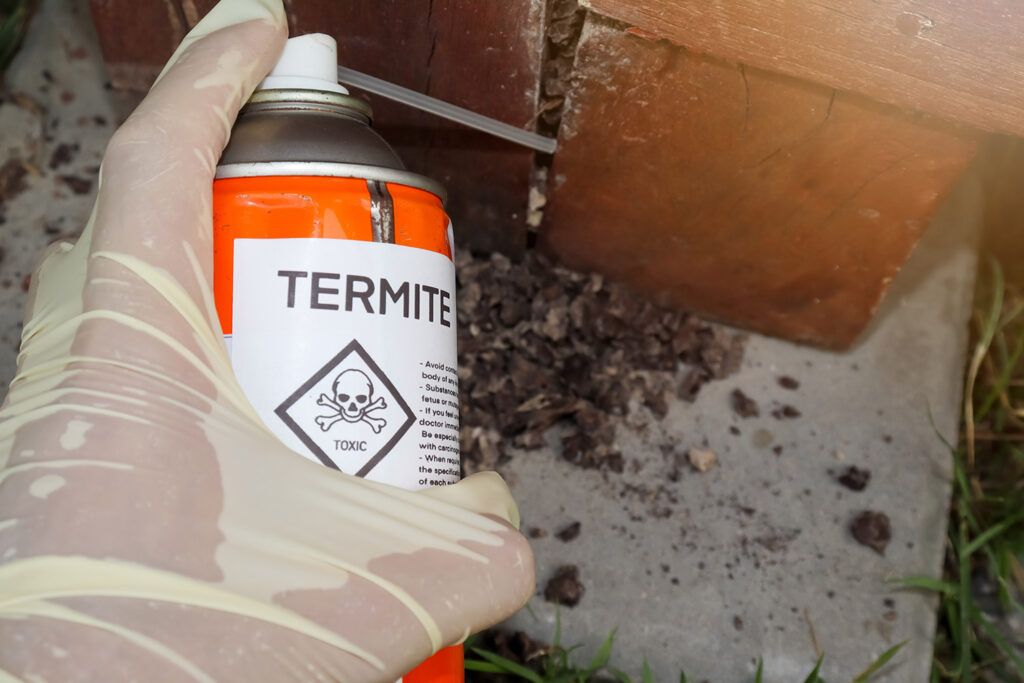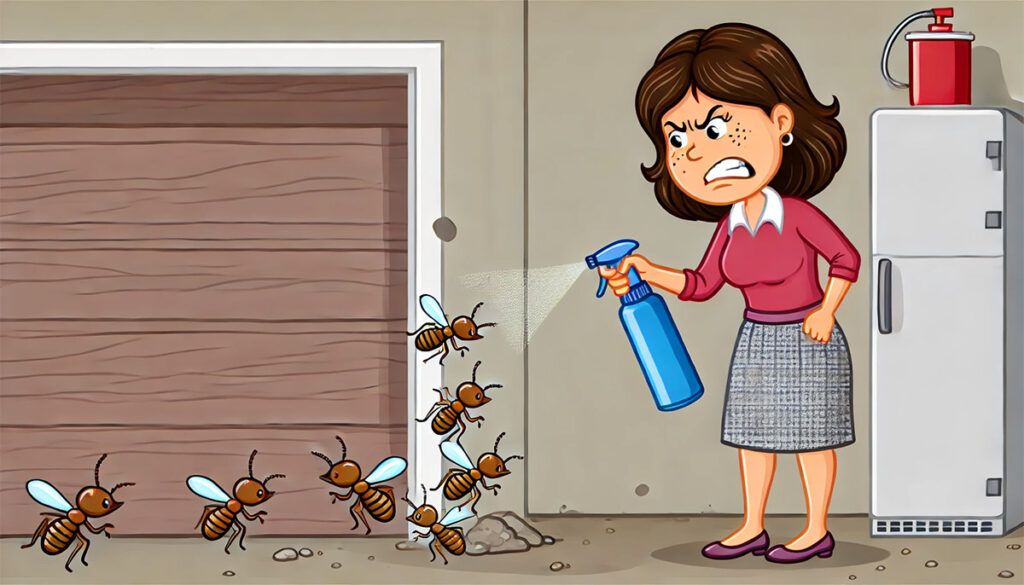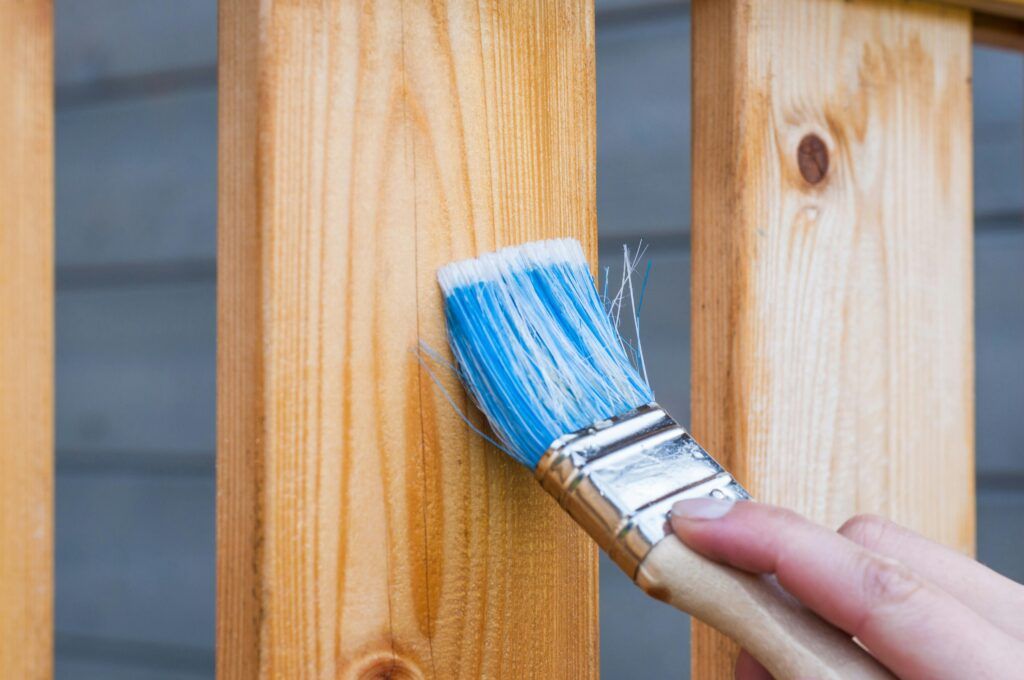How To Kill Termites

Termites can cause major damage and destruction to homes, and what’s worse is that termite activity can often go undetected until it’s too late. When homeowners first start to see signs of termite activity, they have to implement pest control quickly to minimize damage. But before you call in a professional exterminator, you may want to try one of these DIY approaches.
8 DIY Ways To Kill Termites
| Method | How It Works | Application Instructions |
|---|---|---|
| Soapy Water or Salt Water | Suffocates termites by coating their bodies. | Mix soap and water in a spray bottle; apply directly to termites or their nests multiple times. |
| Vinegar | Dehydrates termites’ exoskeletons, leading to death. | Mix half cup of vinegar with juice of two lemons in a spray bottle; apply directly to termites or entry/exit points. |
| Orange Oil or Neem Oil | Breaks down termite exoskeletons (orange oil); prevents laying eggs/molting (neem oil). | Mix with water and dish soap in a spray bottle; apply directly to affected areas multiple times. |
| Boric Acid | Abrasive to termite exoskeletons, causes dehydration and death. | Spray solution on entry/exit sites or directly on termites; use bait stations or sprinkle powder in termite paths. |
| Diatomaceous Earth | Absorbs oils from termite bodies, causing dehydration; scratches exoskeletons. | Sprinkle powder where termites are present; make a solution with water and apply. |
| Petroleum Jelly or Aloe Vera | Suffocates termites by coating their bodies. | Apply directly where termites walk through it. |
| Cardboard Bait | Attracts termites to wet cardboard, which can then be burned. | Wet cardboard and place in areas with termite activity; burn infested cardboard. |
| Nematodes | Parasitic roundworms that inject bacteria into termites. | Mix with water and apply using a spray bottle. |
How Do I Know If I Have Termites?

Aside from taking preventative measures to ensure termites don’t get in your house in the first place, all homeowners should educate themselves about the warning signs of an infestation. Here are a few key indications that you have termites.
Buckling of wood floors or bubbling under paint
Subterranean termites (the most common type of termite in the US) love to burrow into softer woods that are commonly found in subflooring. When this happens, you may start to notice your wood floors start to pop up and take on a convex shape. Termites also love drywall and if they’re living in your walls you may notice a similar thing happen. They will also bring moisture in with them which can cause bubbles to form under your paint.
👉 Related reading: Best Drain Cleaner (2025 Review)
Swarmers present
Swarmers, also called “alates,” are winged termites that cluster together when trying to establish a new colony. When you see swarmers in or around your house, it’s a sign that termites have already started building a new colony.
A word of caution: Take a minute to learn about the differences between flying ants vs termites, since they are commonly mistaken for one another.
Mud tubes
Termites build mud tubes that are about the width of a straw that they use as protected paths in and out of their nests and to and from food sources. You may notice these around the exterior of your home near the foundation or by other food sources like a shed or tree.
Discarded wings
After termites mate, the males break off their wings and you can often find piles of these discarded wings around entry and exit points.
How To Kill Termites

Soapy Water or Salt Water
Because termites get their oxygen intake through their skin, soap can be an effective way to kill them since it coats them and suffocates them. It can also leave a film around termite eggs which will eventually kill them too.
To try this method, simply mix soap and water in a spray bottle and spray on areas where you’ve seen termites, directly on their nest, or onto the termites themselves. Note that you will have to make multiple applications.
Salt water can also have a similar effect, but will also need to be applied multiple times. You can use salt water either in a spray bottle or syringe and spray it into entry and exit sites.
👉 Related: What Is the Best Ant Killer? (2025 Review)
Vinegar
The acetic acid in vinegar will dry out and dehydrate the termite’s exoskeleton which leads to their death. This can be a very effective method – but for the best results, the vinegar needs to be fully concentrated and applied directly to the termite’s bodies, which is a tall order considering most termites are underground. If the vinegar is too diluted, it won’t be nearly as effective and can evaporate quickly.
To do this, mix a half cup of white vinegar with the juice of two lemons in a spray bottle and spray directly onto visible termites, into entry and exit sites, and onto mud holes. Like using kitchen soap and water, vinegar is a safe product for all members of the household.
Orange Oil or Neem Oil
Orange oil contains the substance d-limonene which is toxic to insects but safe for humans. This substance can break apart a termite’s exoskeletons, causing them to die. Neem oil can also be an effective natural pest control because it prevents termites from being able to lay eggs or molt (shed their skin). It can also serve as a deterrent to future termites due to its bitter smell that repels pests. Like orange oil, neem oil will be most effective when the termite comes into direct contact with it and it will likely take multiple applications.
Make a mixture of two cups of warm water, a few drops of dish soap, and roughly ten drops of neem or orange oil into a spray bottle and apply to the affected areas. You’ll want to use the mixture right away as the oils will start to degrade and lose their effectiveness after about 12 hours. These natural oils do work, but they’re best for small-scale infestations, the earliest days of an infestation, and are most effective on above-ground termite activity.
Boric Acid
Boric acid is one of the most popular DIY remedies for termites and is a registered pesticide with the EPA, though it’s more effective on dry wood insects than subterranean insects. The abrasive quality of boric acid slowly breaks a termite’s exoskeleton, thereby dehydrating them and causing them to die. Termites will also carry the boric acid back to their colony and infect others. Like most natural remedies, boric acid is best for smaller infestations.
👉 Is boric acid safe for pets?
In general, boric acid is believed to be safe for both humans and pets in the house, but if large amounts of it are ingested by household dogs or cats, it can harm their circulatory and respiratory systems. When you use boric acid in termite control, precautions should be taken to keep pets and small children away from it.
You can make a solution of boric acid and spray it on entry and exit sites, in cracks and crevices where you think termites might get through, or directly onto termites. You can also purchase bait stations with boric acid in them that the termites ingest and then carry on to others, or you can sprinkle the powder by itself in areas that termites walk across.
Diatomaceous Earth
Like boric acid, diatomaceous earth (also called silicon dioxide, or just “DE”) is another all-natural pesticide. DE is a chalk-like sedimentary rock that’s sold as a fine, white powder.
👉 Is diatomaceous earth safe for pets?
DE is generally considered to be non-toxic to humans and animals, except in cases of skin or eye exposure where it can cause irritation. Because of this, you should avoid using it in areas where a pet may roll around in it. When diatomaceous earth comes into contact with a termite’s body it absorbs their oils, causing the bug to dehydrate and die. It can also scratch at the exoskeleton of the termite like boric acid, causing it to break down.
To use it, simply sprinkle the diatomaceous earth where termites are present. You can also make a solution with water and when this dries it will leave a film of DE. Importantly, diatomaceous earth must be dry in order to work properly and you may have to repeat the application process.
Petroleum Jelly or Aloe Vera
Both petroleum jelly and aloe vera can be used in small applications to kill termites, but they won’t be effective on a large scale. These products work by essentially suffocating the termite when they become coated in the substance.
To use, simply place the aloe vera or petroleum jelly where termites are likely to walk through it. Petroleum jelly has the added bonus of working as a deterrent since it has phenol in it, an odor that repels insects.
Cardboard Bait
Termites feed on wood products and cellulose and are attracted to anything they can easily burrow into and eat. Because of this, using plain cardboard as bait can be an easy and cost-effective way to manage termites.
To use a cardboard bait station, you’ll simply wet pieces of cardboard or boxes and leave them in places where termites are likely to gather. Once you see they’ve infested it you can burn the entire box along with the termites. Note that you will have to do this a few times and it won’t necessarily get rid of all termites.
Nematodes
Nematodes are parasitic, microscopic roundworms that naturally prey upon termites by injecting them with bacteria and then eating them.
In theory, nematodes can be very effective and are harmless to people and pets. However, if you’re dealing with a sizable infestation, the amount of nematodes you’d need to address it would be prohibitive. Mix the nematodes with water and apply the substance using a spray bottle.
How To Prevent Termites

Prevention is key when it comes to keeping your home pest-free, and though none of these measures are foolproof, they can do a lot to ensure termites steer clear of your home. However, even the most vigilant homeowners can still be surprised by an infestation because a termite swarm can do serious damage before you can even detect it.
The following pest control tips can help stop termites from infesting your home:
- Fix leaks: Address any water leaks in your house right away. Termites love a moist place to build their colony and the drier you can keep your home the better. This is especially true if you have water dripping onto wood, stucco, or drywall.
- Protect wood: Only use pressure-treated lumber anywhere that the wood meets the ground. You should also be sure to stack your firewood as far away from your home as possible.
- Ventilate: When your home is properly ventilated, this will keep air moving and prevent moisture from building up. This is especially true of basements, crawlspaces, and attics.
- Cleaning gutters regularly: Gutters can easily become clogged which means water is just sitting in there creating the perfect home for termites. Additionally, standing water in gutters can rot away the wood around the eaves of your home.
- Keep a clean foundation: Clear away all plants, vegetation, and mulch from the perimeter of your home. They can retain moisture which attracts termites.
Terminate Your Termite Troubles
While these home remedies are definitely worth trying and can be effective against termites, you should also consider hiring a professional exterminator if the infestation is extensive. If you live in an area of the country that sees a lot of termite activity like the Southeastern states, you may also consider purchasing a termite bond. These bonds can give many homeowners peace of mind knowing that their homes are protected and any damage that is done by termites will be covered.
All in all, by taking some basic preventive steps and knowing the warning signs to look out for, there are solutions available to those who are dealing with termites. The at-home, DIY approaches are certainly cheaper than calling one of the best pest control companies, and may be all you need if you catch it early enough. In other cases, a professional may need to be called in to properly treat the infestation.